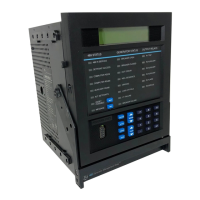B-2 489 Generator Management Relay
GE Power Management
B.1 STATOR GROUND FAULT PROTECTION APPENDIX B
B
When several small generators are operated in parallel with a single step-up transformer, all generators may be grounded
through the same impedance (the impedance normally consists of a distribution transformer and a properly sized resistor).
It is possible that only one generator is grounded while the others have a floating neutral point when connected to the
power grid (see the figure below). This operating mode is often adopted to prevent circulation of third-harmonic currents
through the generators, if the installation is such that all the star points would end up connected together ahead of the com-
mon grounding impedance (if each generator has its own grounding impedance, the magnitude of the circulating third har-
monic current will be quite small). With a common ground point, the same
V
neutral
signal is brought to all the relays but only
the one which is grounded should have the neutral overvoltage element in service.
For these cases, the neutral overvoltage element has been provided with a supervising signal obtained from an auxiliary
contact off the grounding switch. When the grounding switch is opened, the element is disabled. The grounding switch aux-
iliary contact is also used in the ground directional element, as is the breaker auxiliary contact, as discussed later.
If all the generators are left grounded through the same impedance, the neutral overvoltage element in each relay will
respond to a ground fault in any of the generators. For this reason, the ground directional element should be used in each
relay, in addition to the neutral overvoltage element.
Figure B–2: PARALLEL GENERATORS WITH COMMON GROUNDING IMPEDANCE
PARGEN1R2.CDR
Other Generators,
as the case may be
489
Relay
V
neutral
Aux.
Contact
G2
Aux.
Contact
Breaker
Grounding
Switch
Grounding
Switch
Trans. & R
Aux.
Contact
V
neutral
G1
Common
Grounding
Impedance
Isolating
Trans.
489
Relay
Breaker
Aux.
Contact

